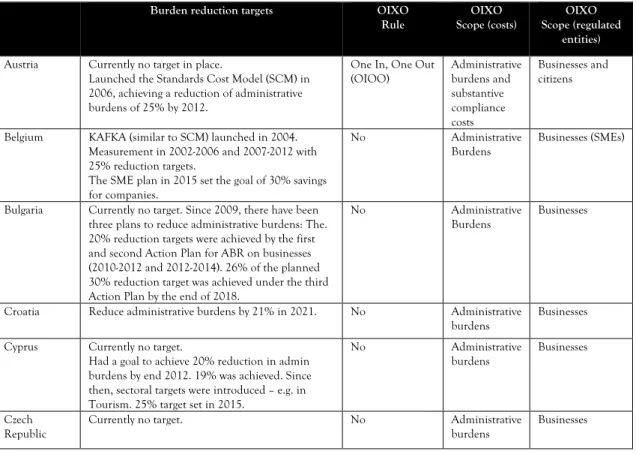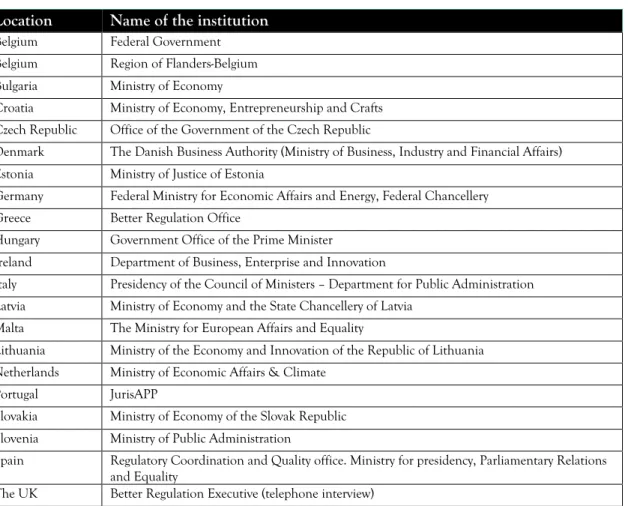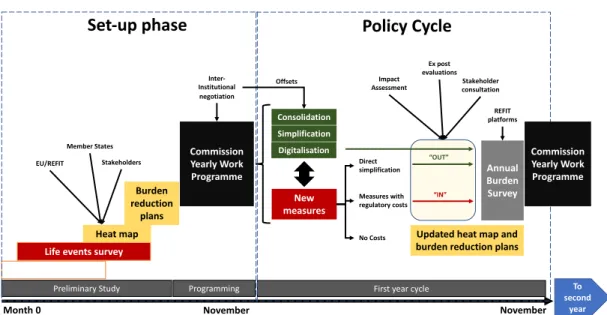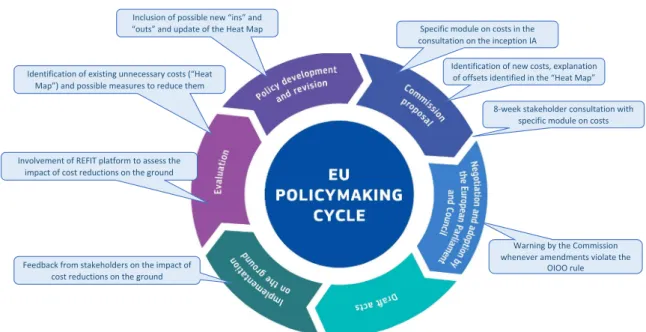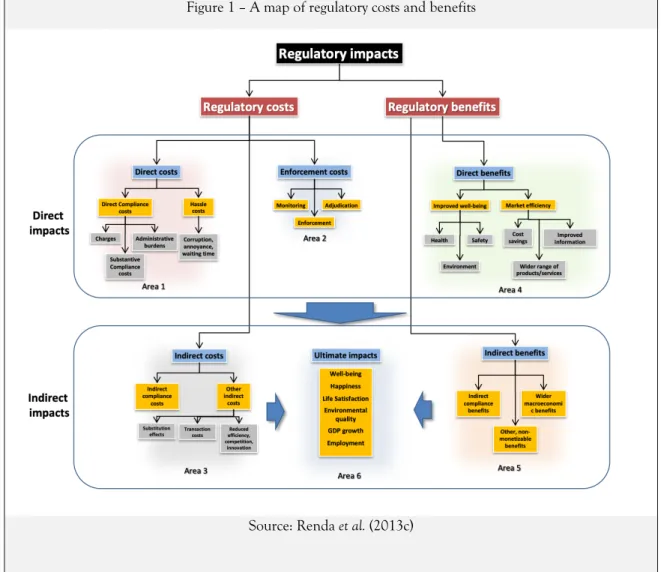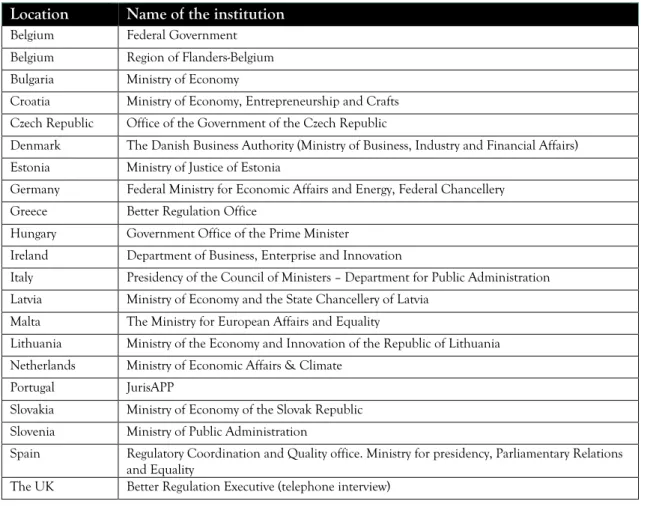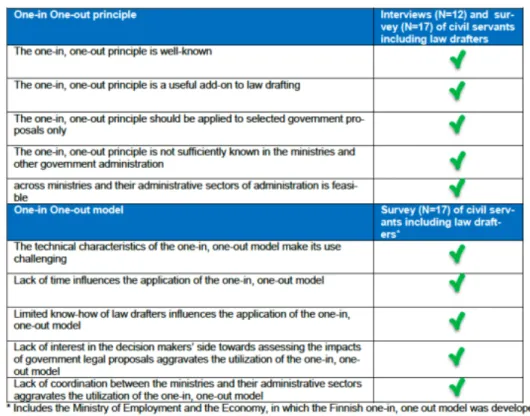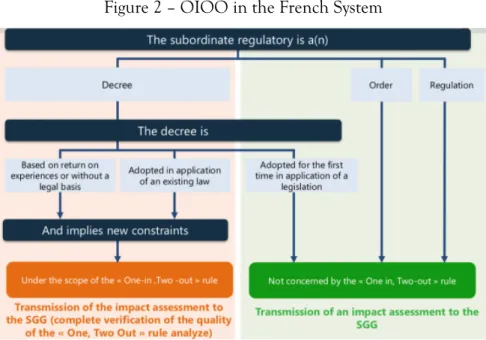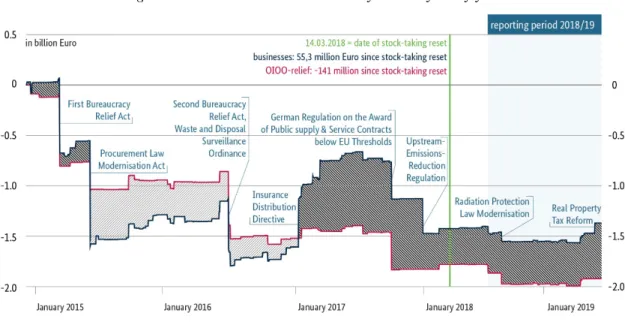F EASIBILITY STUDY : I NTRODUCING
“O NE -I N -O NE -O UT ” IN THE E UROPEAN C OMMISSION
Final Report
for the German Ministry for Economic Affairs and Energy Presented by the Centre for European Policy Studies
Lead Author:
Andrea Renda
Senior Research Fellow, CEPS
Research team:
Moritz Laurer, Ada Modzelewska, Antonella Zarra
5 December 2019
T ABLE OF CONTENTS
E
XECUTIVES
UMMARY6
I
NTRODUCTION18
1 T
HE EXPERIENCE WITHO
NE-I
N-X-O
UT RULES INEU
AND
OECD
COUNTRIES25
1.1 Experience in the EU Member states 25
1.1.1 Austria 25
1.1.2 Denmark 26
1.1.3 Finland 27
1.1.4 France 28
1.1.5 Germany 30
1.1.6 Hungary 33
1.1.7 Italy 34
1.1.8 Latvia 34
1.1.9 Lithuania 36
1.1.10 Portugal 37
1.1.11 Spain 37
1.1.12 Sweden 38
1.1.13 The United Kingdom 39
1.2 EU countries considering the introduction of an OIXO rule 40 1.3 EU Member States with no experience with OIXO rules: the
reasons stated by the survey respondents 41
1.4 OIXO rules in non-EU OECD countries 42
1.4.1 Canada 42
1.4.2 Korea 44
1.4.3 Mexico 46
1.4.4 The United States 48
1.5 Summary table and graph: OIXO rules in Europe and beyond 51
2 E
XPERIENCE OFEU
ANDOECD
COUNTRIES WITHBURDEN REDUCTION TARGETS
59
2.1 Experience in the EU Member States 59
2.1.1 Austria 59
2.1.2 Belgium 60
2.1.3 Bulgaria 62
2.1.4 Croatia 63
2.1.5 Cyprus 64
2.1.6 Czech Republic 65
2.1.7 Denmark 65
2.1.8 Estonia 66
2.1.9 Finland 67
2.1.10 France 68
2.1.11 Germany 70
2.1.12 Greece 71
2.1.13 Hungary 72
2.1.14 Ireland 73
2.1.15 Italy 73
2.1.16 Latvia 74
2.1.17 Lithuania 75
2.1.18 Luxembourg 75
2.1.19 Malta 76
2.1.20 The Netherlands 76
2.1.21 Poland 77
2.1.22 Portugal 78
2.1.23 Romania 79
2.1.24 Slovakia 79
2.1.25 Slovenia 80
2.1.26 Sweden 82
2.1.27 Spain 83
2.1.28 The United Kingdom 83
2.2 Non-EU OECD countries 83
2.3 Summary and comparison of national experiences 88
3 T
OWARDS A POSSIBLEOIOO
RULE AT THEEU
LEVEL97
3.1 The Juncker Commission’s arguments against burden reduction
targets and OIXO: an analysis 98
3.1.1 It is widely acknowledged that baseline measurements are not cost-
effective 100
3.1.2 OIXO rules and burden reduction targets are not incompatible with an
ambitious policy agenda 101
3.1.3 OIXO rules and burden reduction targets do not necessarily lead to a
lack of legitimacy and acceptance by the stakeholders 103 3.1.4 It is true that reducing unnecessary costs requires reliable quantitative
estimates: but this applies also to the current better regulation agenda 104 3.1.5 The future OIOO rule should target only unnecessary burdens 105 3.1.6 Calibrating the ambition of any ex ante objective requires evidence and
stakeholder consultation 105
3.1.7 The adoption of burden reduction targets should avoid undesirable
behavioural impacts 106
3.1.8 OIXO rules and burden reduction targets can help strengthen the
accountability of co-legislators 106
3.1.9 Arguments related to multi-level governance are not directly related to
OIXO rules or burden reduction targets 107
3.1.10 A well-designed OIXO rule would not create delays 109
3.2 Feedback from surveyed national governments 110
3.3 Introducing an OIOO system at the EU level: opportunities,
challenges, and risks 112
3.3.1 Key Preconditions 112
3.3.2 Designing an integrated system: key features 117
3.3.3 Implementing the system 119
3.3.4 A step-by-step approach to implementing the system 124
4 C
ONCLUDING REMARKS127
R
EFERENCES131
A
NNEX1: Q
UESTIONNAIRE137
L IST OF F IGURES
Figure A – The experience of EU Member States with OIXO rules ... 7
Figure B – Step-by-step implementation of the new system ... 15
Figure C – Additions to the existing policy cycle ... 16
Figure 1 – A map of regulatory costs and benefits ... 19
Figure 2 – OIOO in the French System ... 30
Figure 3 – One in one out in Germany: results year by year ... 33
Figure 4 – The Mechanics of the One-for-one rule in Canada ... 43
Figure 5 – the new regulatory budgeting system – fiscal year cycle ... 50
Figure 6 – The experience of EU Member States with OIXO rules ... 58
Figure 7 – Three and a half decades of deregulation in Australia ... 85
Figure 8 – EO13771: savings targets and savings achieved ... 86
Figure 9 – The heat map and burden reduction plans: inputs, format, content ... 122
Figure 10 – Step-by-step implementation of the new system ... 125
Figure 11 – Additions to the existing policy cycle ... 126
L IST OF T ABLES
Table A – Overview of the experience with OIXO rules in EU member states and non-EU OECD Countries ... 7Table B – Replies to our survey (including telephone interviews) ... 11
Table C – Key features of the proposed system ... 13
Table D – How the proposed system addresses the concerns expressed by the European Commission ... 16
Table 1 – Replies to our survey (including telephone interviews) ... 24
Table 2 - Key findings in an empirical survey of civil servants including law drafters ... 28
Table 3 – Calculation of net benefits in RIA and CICO system in Korea ... 45
Table 4 – Overview of the experience with OIXO rules in EU member states and non-EU OECD Countries ... 52
Table 5 – 2019 regulatory budget goals and actual savings as of April 2019, United States ... 87
Table 6 – Summary table for EU countries and non-EU OECD-Countries ... 90
Table 7 – Key features of the proposed system ... 119
Table 8 – How the proposed system addresses the concerns expressed by the European Commission ... 128
F EASIBILITY S TUDY : I NTRODUCING
“O NE -I N -O NE -O UT ” IN THE E UROPEAN C OMMISSION
E
XECUTIVES
UMMARYhe need to consolidate and streamline the stock of legislation and reduce the unnecessary costs associated with legal rules has been increasingly felt by regulated stakeholders and governments in many developed and emerging economies. In many OECD countries, including many EU Member States and Canada, Korea, Mexico, the United States, this has led governments of various political orientations to introduce forms of regulatory budgeting, in which administrations are asked to identify, whenever new provisions introduce regulatory costs, existing provisions that could be repealed or revised, thereby offsetting the cost increase. In some countries these rules have implied a one-to-one offset, whereas in other countries the provisions imposed also a reduction, as in the case of UK’s one-in-two-out and one-in-three-out rules, and the US one-in-two-out rule.
This is why we generically refer to these rules as “One-In-X-Out”, or OIXO. Moreover, many countries have also experimented with a complementary strategy, which implies the setting of ad hoc burden reduction targets, either for all legislation or for specific sectors. In fact, OIXO-rules are just a specific from of burden reduction targets – with the level of the target
“Out” being linked to the flow of new regulations “In”.
Based on our data collection, there are ten EU member states in which an OIXO rule is in place: Austria, Finland (pilot), France, Germany, Hungary, Italy, Latvia, Lithuania, Spain and Sweden; two countries where the rule has been in place and was currently discontinued (Denmark and the UK); and one country in which the rule was formally announced, but was not implemented (Portugal). Four other countries are reportedly considering the introduction of such rule: Poland, Romania, Slovakia, Slovenia.
Altogether these countries represent more than 86% of the EU28 GDP and 86% of the EU28 population. Even considering only the ten countries with an OIXO rule currently in place, they account for 62% of the EU GDP and 58% of the EU population.
Figure A below maps the diffusion of the OIXO rule in the EU28, with an indication of those countries in which an OIXO rule is currently in place (deep blue); countries in which the introduction of the rule is currently being planned (blue); and countries in which the rule used to be in place, but was recently discontinued (light yellow); countries in which the OIXO rule formally exists, but is not being implemented (yellow). Countries where no such rule is in place are marked in brown.
T
Figure A – The experience of EU Member States with OIXO rules
Table A below summarises the experience in EU countries with both OIXO rules and burden reduction targets.
Table A – Overview of the experience with OIXO rules and burden reduction targets in EU Member States
Burden reduction targets OIXO
Rule
OIXO Scope (costs)
OIXO Scope (regulated
entities) Austria Currently no target in place.
Launched the Standards Cost Model (SCM) in 2006, achieving a reduction of administrative burdens of 25% by 2012.
One In, One Out (OIOO)
Administrative burdens and substantive compliance costs
Businesses and citizens
Belgium KAFKA (similar to SCM) launched in 2004.
Measurement in 2002-2006 and 2007-2012 with 25% reduction targets.
The SME plan in 2015 set the goal of 30% savings for companies.
No Administrative
Burdens
Businesses (SMEs)
Bulgaria Currently no target. Since 2009, there have been three plans to reduce administrative burdens: The.
20% reduction targets were achieved by the first and second Action Plan for ABR on businesses (2010-2012 and 2012-2014). 26% of the planned 30% reduction target was achieved under the third Action Plan by the end of 2018.
No Administrative
Burdens
Businesses
Croatia Reduce administrative burdens by 21% in 2021. No Administrative burdens
Businesses Cyprus Currently no target.
Had a goal to achieve 20% reduction in admin burdens by end 2012. 19% was achieved. Since then, sectoral targets were introduced – e.g. in Tourism. 25% target set in 2015.
No Administrative
burdens
Businesses
Czech Republic
Currently no target. No Administrative
burdens
Businesses OIXO is in place
OIXO is planned
OIXO recently discontinued OIXO exists but not implemented OIXO not in place
Applied the SCM since 2005. In 2016, a 31.49%
reduction was found compared to 2005. Then new long-term goals were set to reduce the burden by 2020 and carry out another measurement in 2021.
Denmark During 2004-2010, the application of the SCM led to a 24.6% decrease in administrative burdens.
The previous government’s reduction target of 4 billion DKK in 2020 and additionally 2 billion DKK in 2025 compared to 2015 has been discontinued by the new government appointed this summer.
OIOO (discontinued by the new government in the summer of 2019)
Administrative burdens and substantive compliance costs
Businesses
Greece 25% reduction of administrative burdens: results presented in 2014.
No Administrative
burdens
Businesses Estonia No current target, but rather a zero-bureaucracy
plan.
The SCM was applied since 2009, focused on four areas.
No Businesses and
citizens
Finland No current target.
Measured administrative burdens in 2008-2012, aiming at a 25% reduction.
Pilot test still ongoing in the Ministry of Economic Affairs and
Employment.
Administrative burdens and substantive compliance costs
Businesses
France No current target.
Attempted to apply the SCM since 2004, then moved to life events surveys.
OI2O Administrative
burdens and substantive compliance costs
Businesses, local administration and services, citizens Germany Since 2006 there was a net target, achieved in 2012,
leading to a 25% reduction. Since then a Bureaucracy Cost Index is maintained. Since 2015 a OIOO rule is in place.
OIOO Administrative
burdens and substantive compliance costs
Businesses
Hungary Cutting Red Tape Programme for Businesses (2011) and additional measures helped to achieve the target of 25% administrative burden reduction.
“Programme for a more competitive Hungary”
(2018) affects several areas, with altogether 42 actions. Results were achieved also by Good Governance – Magyary Programme (2010-2014) and the Public Administration and Public Service Development Strategy (2014-2020).
Currently no target (%) in place. Cutting red tape is still a priority for Hungary. The focus is on the most burdensome areas.
OIOO Administrative
burdens and substantive compliance costs
Businesses, citizens and public administration
Ireland No current target.
Applied the SCM in 2008-2012, aiming at a 25%
reduction. By November 2012 an estimated 18.6%
had been achieved.
No
Italy No current target.
Applied the SCM in 2007-2012, aiming at a 25%
reduction.
OIOO Administrative
burdens
Citizens and businesses Latvia No current target.
Had a reduction plan in 2009-2015 (but no precise methodology).
OIOO Administrative
burdens and substantive compliance costs
Businesses
Lithuania No current target.
Had a plan that aimed at 30% reduction in particular areas, but the goal was not reached.
OIOO Administrative
burdens
Businesses
Luxembourg No current target.
The 2009-14 plan set a national target for reducing administrative burdens by 15% by 2012 in four priority areas.
No
Malta No current target.
In 2008 committed to reduce administrative burden on businesses by 15% by 2012 using the SCM methodology. In 2018, committed to reduce
No Administrative
burdens
Businesses
bureaucracy by a further 30% during this legislature.
Netherlands No current target.
In the past it was a pioneer with MISTRAL in 1994, SCM in 2003-2007, and then second baseline measurement. Set a structural net reduction target of 2.5 billion Euros for businesses, professionals and citizens by 2017 compared to 2012 levels.
No Administrative
burdens and substantive compliance costs
Businesses and citizens
Poland No current target.
Had a target for 2008-2010, aimed at a 25%
reduction. Then a new Strategy in 2012, with new targets to achieve a reduction equivalent to 1%
GDP by 2015 and 1.5% by 2020.
Currently planned
Administrative burdens and substantive compliance costs
Businesses
Portugal No current target. .
Launched a reduction programme in 2007 with 25% target until 2012.
OIOO Administrative
burdens
Businesses
Romania No current target. Planned
Slovakia Two plans, in 2009 and in 2015. In March 2015 66 new measures related to seven ministries aimed at an estimated reduction goal of about 55 million Euros.
Planned Administrative burdens
Businesses
Slovenia In 2007 Slovenia adopted the Standard Cost Model (SCM). In 2009 objectives were set for administrative burden reduction and elimination of administrative barriers by 25 % by the end of 2015 (365 mio EUR or 27% realized). After 2015 there has been objective to reduce administratitive burden by minimum of 5 MIO EUR per year.
Planned
Spain No. Had a plan in 2007-2012, and a net reduction target of 30%, which was achieved.
OIOO Administrative
burdens
Businesses Sweden Administrative costs for businesses should be lower
in 2020 compared to 2012.
In the past it applied the SCM in 2006-2012, with 25% target (but only 7% was achieved).
OIOO Administrative
burdens
Businesses
The UK* 10bn pound savings set in 2015, current BIT at 9bn pound.
OIOO in 2011;
OI2O in 2013;
OI3O in 2016 and 2017. OIXO not in force since 2017.
Administrative burdens and substantive compliance costs
Businesses
* At the moment of drafting this report, the UK is still a Member of the European Union.
Overall, national experiences with OIXO rules have led to positive results: hence, many EU Member States have started to advocate the adoption of a similar strategy also at the EU level. These calls are reflected in various Conclusions of the Council of the EU (December 2014, May 2016, March 2018, November 2018 and May 2019). The European Commission acknowledged the requests formulated by the Council over the years and also recalled that paragraph 48 of the Interinstitutional Agreement on Better Law-Making calls for an assessment of the feasibility of establishing objectives for burden reduction. While acknowledging these requests, the Juncker Commission had stated its intention to maintain a case-by-case approach to the reduction of regulatory burdens. In its Communication on “Completing the Better Regulation Agenda”1, adopted in October 2017, and in the more recent Staff Working Paper and Communication on “Taking Stock
1 COM(2017) 651: Completing the Better Regulation Agenda: Better solutions for better results.
https://ec.europa.eu/info/sites/info/files/completing-the-better-regulation-agenda-better-solutions-for-better- results_en.pdf.
of the Commission’s Better Regulation Agenda”2, published in April 2019, the Juncker Commission argued that “upfront targets” would not offer certain fundamental guarantees:
in particular, they would adversely affect underlying policy objectives and the need to ensure democratic accountability and transparency, which requires “a political decision on which costs are legitimate to achieve policy goals and which instead should be eliminated”.
Such decision, the Commission explained, should be “based on evidence from a case-to- case assessment that responds to the concerns of stakeholders and people”. However, empirical evidence collected by the Commission has revealed that stakeholders are prevalently unsatisfied about the Commission’s previous efforts to simplify legislation.
TOWARDS AN EUOIXO RULE
Most recently, the new President of the European Commission, Ursula von der Leyen, announced that the Commission will apply the “‘One-In, One-Out’ (OIOO) principle
“to cut red tape”3. In her mission letters to the designated members of the College of Commissioners, the new President stated that “the Commission will develop a new instrument to deliver on a ‘One In, One Out’ principle”, adding that “every legislative proposal creating new burdens should relieve people and businesses of an equivalent existing burden at EU level in the same policy area”; and that the Commission “will also work with Member States to ensure that, when transposing EU legislation, they do not add unnecessary administrative burdens”4. The OIOO principle is already specified in the newly adopted document on the “Main principles of the working methods”, where the Commission further specified that it will adopt a “whole-of-government” approach, and consequently introduced the OIOO principle without limiting it to specific sectors or policy areas. The document mentions that the principle is being introduced in order to send “a clear and credible signal to citizens that its policies and proposals deliver and make life easier”5.
The OIOO principle is thus now officially part of the better regulation agenda in the European Commission: however, its contours and modus operandi must still be defined.
This Feasibility Study responds to this need by taking stock of the largely positive experience of EU and non-EU OECD countries with OIXO rules and burden reduction targets, and at the same time considering the concerns expressed by the Juncker Commission (and by a small group of Member States) on the risk that the new system causes delays, jeopardises the achievement of the Commission’s agenda, and leads to inefficient incentives for Commission officials. Apart from available literature at the international level, we have collected information through a survey, which retrieved 21 useful results (see table below).
2 COM(2019) 156: Taking Stock of the Commission's Better Regulation Agenda
https://ec.europa.eu/info/sites/info/files/better-regulation-taking-stock-swd_en.pdf.
3https://europa.eu/rapid/press-release_IP-19-5542_en.htm
4 See, for example https://ec.europa.eu/commission/sites/beta-political/files/mission-letter-maros-sefcovic-2019_en.pdf
5 https://ec.europa.eu/commission/sites/beta-political/files/working-methods-principles_en.pdf
Table B – Replies to our survey
Location Name of the institution
Belgium Federal Government Belgium Region of Flanders-Belgium Bulgaria Ministry of Economy
Croatia Ministry of Economy, Entrepreneurship and Crafts Czech Republic Office of the Government of the Czech Republic
Denmark The Danish Business Authority (Ministry of Business, Industry and Financial Affairs) Estonia Ministry of Justice of Estonia
Germany Federal Ministry for Economic Affairs and Energy, Federal Chancellery Greece Better Regulation Office
Hungary Government Office of the Prime Minister
Ireland Department of Business, Enterprise and Innovation
Italy Presidency of the Council of Ministers – Department for Public Administration Latvia Ministry of Economy and the State Chancellery of Latvia
Malta The Ministry for European Affairs and Equality
Lithuania Ministry of the Economy and Innovation of the Republic of Lithuania Netherlands Ministry of Economic Affairs & Climate
Portugal JurisAPP
Slovakia Ministry of Economy of the Slovak Republic Slovenia Ministry of Public Administration
Spain Regulatory Coordination and Quality office. Ministry for presidency, Parliamentary Relations and Equality
The UK Better Regulation Executive (telephone interview)
Based on the results of our analysis, we developed a proposed system, which would be likely to achieve the positive results observed in Member States and other OECD countries, while at the same time mitigating or fully addressing the concerns expressed by the “old” Commission, which are tackled one by one in Section 3 below. We also set key preconditions that a future OIOO rule should satisfy. They include a firm political commitment, strong multi-level governance, greater re-use and sharing of data and information on existing and upcoming regulations, and emphasis on communication, rather than a mechanistic, algebraic approach to “ins” and “outs”. We have built a system that is rooted in the Interinstitutional Agreement on Better Law-Making and respects the peculiarities of the EU better regulation agenda, to ensure that in line with what is happening in many European countries, the implementation of these tools does not jeopardise the achievement of EU’s policy agenda.
FEATURES OF THE PROPOSED EUOIOO RULE
• We propose that the rule takes the form of an OIOO rule (thus, X = 1), in a way that mirrors most of the national experience we have surveyed. The choice of an OIOO rule is also motivated by the need to avoid that the rule introduced places excessive pressure on the EU administration to identify and reduce costs generated by the acquis; as a matter of fact, the proposed rule is aimed at enabling gradual awareness of existing unnecessary costs, and a gradual improvement of the quality of the regulatory stock through the introduction of necessary “ins” and the removal of unnecessary “outs”.
• The OIOO rule would cover all direct compliance costs, thus including administrative burdens, substantive compliance costs, and charges where existing. As a matter of fact, in the systems, which have adopted this wider approach and not only focused on administrative burdens, the most significant positive results have been observed. This can be explained by the fact that substantive compliance costs are, in most cases, more significant than administrative burdens.
• Within the proposed system, all newly introduced costs count as “ins”. While “ins”
ideally always correspond to necessary costs, “outs” can only be costs that were found to be unnecessary. Again, we define “unnecessary burdens” as corresponding to unnecessary administrative costs, unnecessary substantive compliance costs, and unnecessary charges. These are the cost categories that will be included in our proposed
“burden reduction plans”.
• The proposed OIOO rule would apply to businesses and citizens, in order to ensure that both can benefit from an improvement of the EU acquis, and the elimination of unnecessary costs. This would also be important to build ownership of the new system among all stakeholders, and avoid that reduction measures are exclusively focused on one category. Over time, also public administrations could be covered by the rule, but this would require a high degree of coordination between the European Commission and Member States.
• The proposed system would allow for banking of cost reductions achieved, subject to the achievement of the overall cost reduction plan.6 Banking, however, works both ways: in case of failure to achieve the planned reductions during a given year, the reductions to be achieved would then be passed onto the following year.
• The proposed system will cover recurrent costs, not one-off costs. The overall aim of the system is to reduce or, where possible, eliminate the unnecessary costs generated by existing EU rules: the one-off costs that emerge as a result of the introduction of a new rule are typically not “actionable” once they have been faced by regulated entities, no matter whether the administration seeks to simplify, consolidate legislation or seek digital solutions.
• The system would in principle not allow for trading burden reductions, since this would lead to a possible confusion of regulatory costs and benefits, with potentially
6 For an explanation of “banking” see Box 2 at page 17.
significant distributional consequences. Only in exceptional circumstances, and following a formal political decision (e.g. at the College level), trading could be admitted, if the area in which “ins” are being introduced does not feature unnecessary costs, and other areas can be identified, in which measures could be adopted without affecting regulatory objectives or creating undesirable distributional impacts. The proposal should be assessed with a view to demonstrating that the new costs are justified by the achievement of superior regulatory benefits.
• As the proposed OIOO-system is not a strict, mechanistic rule, complete exemptions from the system are not necessary. This holds especially true as in the proposed OIOO- system banking and, in exceptional circumstances, also trading provide sufficient flexibility. Outright exemptions would threat to undermine the effectiveness of the system.
• The proposed OIOO rule would require oversight, preferably by the Regulatory Scrutiny Board7, who would be asked to oversee the correct implementation of the rule, and ensure in particular: that ex ante impact assessments contain a section on the application of the OIOO rule, and that “ins” correspond to necessary costs; that “ins and “outs” are correctly measured using the same agreed methodology ;and that ex post evaluations report on possible unnecessary cost.
• The proposed rule would require supervision and coordination by the Secretariat- General of the European Commission, in particular for what concerns the procedural steps that will be described in the next Section (i.e., the development and update of a
“heat map”, the adoption and update of burden reduction plans); and for the transparent reporting of the “ins” and “outs”, in particular in the Annual Burden Survey.
Table C below shows the main characteristics of the proposed system.
Table C – The proposed OIOO system at the EU level8 Country Rule Type of costs
covered
Scope (law)
Regulated entities
Timing of offsets
Banking Trading Exemptions
EU OIOO Direct
compliance costs (charges, administrative burdens, compliance costs)
All EU legislation
Citizens and businesses (and over time, possibly also public administrations)
By year end
Yes Only in exceptional circumstances
No
7 For more information on the Regulatory Scrutiny Board see https://ec.europa.eu/info/law/law-making-
process/regulatory-scrutiny-board_en.
8 For the taxonomy see Boxes 1 and 2 in the introduction.
IMPLEMENTING THE OIOO RULE
Figure B below shows our proposal for a possible step-by-step implementation of an OIOO system at the EU level in combination with burden reduction plans, that should help to systematically identify possible “outs”. Two distinct phases are distinguished: a one-off set- up phase, and a yearly cycle.
• In the set-up phase, the Commission launches the preliminary study and a “life events” survey. Results are processed and presented with the presentation of a “heat map”, aimed at enabling the identification of the policy areas in which unnecessary costs (which we define as “unnecessary burdens”, and encompass unnecessary charges, unnecessary administrative burdens and unnecessary substantive compliance costs) were identified, and could be reduced or eliminated. The heat map is subject to consultation of the REFIT Platform9, and then converted into “burden reduction plans” for each policy area (for each Directorate General). This will be a relatively
“loose” OIOO system, meaning that, as explained in the previous section, it would not require that for every Euro of regulatory costs introduced, a Euro of regulatory costs is contextually removed; and would not require the repeal of legislation, but contemplates also the revision of legislation. The system, together with the description of the OIOO rule would be officially launched when the Commission’s yearly Work Programme is presented.
• In the yearly cycle, new measures proposed, with ad hoc changes in the stakeholder consultation and in the ex ante impact assessment10. Impact assessments feature an indication of the “ins” and a specification of where the “outs” will be achieved, and by when. The stakeholder consultations foreseen during the policy cycle carry a specific mention of direct compliance costs, and the REFIT Platform groups are involved in the finalization of the Annual Burden Survey. The heat map is updated annually. The Annual Burden Survey also takes stock on what has been achieved for each policy domain, through which measures (simplification, consolidation, digitalisation), and what could be banked (or added to the expected target) during the following year.
9 For more information on the REFIT Platform, see https://ec.europa.eu/info/law/law-making-process/evaluating-and-
improving-existing-laws/refit-making-eu-law-simpler-and-less-costly/refit-platform_en.
10 Ex post evaluations of existing legislation may also be required to highlight the existence of unnecessarily high or redundant regulatory costs.
Figure B – Step-by-step implementation of the new system
Figure C shows how the yearly OIOO cycle can be integrated with the EU policy cycle. The figure is based on the representation of the policy cycle offered by the European Commission in its latest stocktaking Communication on better regulation. As shown in the figure, compared to the existing policy cycle, the new OIOO rule would entail a number of additions to the current policy cycle, including:
• A specific module on costs in the 12-week consultation on the Inception Impact Assessments and in the 8-week consultation on the finalised Commission proposal.
• A new section dedicated to the OIOO rule in the ex ante impact assessment, in which new “necessary” costs (“ins”) are estimated, and unnecessary costs to be eliminated (“outs”) are identified from the heat map.
• The possibility for the Commission to warn co-legislators whenever proposed amendments risk violating the OIOO rule, since they introduce new costs not accounted for in the original proposal or fail to achieve the planned reduction of unnecessary costs.
• During the implementation phase, the collection of feedback from stakeholders (through “Lighten the Load-Have your Say”)11 and from the REFIT platform on the effective reduction of unnecessary costs.
• In the ex post evaluation, the identification of the need for new regulatory measures (and possible new “ins”); or the existence of unnecessary costs, which could be reduced through measures such as simplification, consolidation or digitalisation (“outs”). This
11 Lighten the Load- Have Your Say is a platform that enables stakeholders to propose reforms that improve laws and
reduce regulatory burdens. See https://ec.europa.eu/info/law/better-regulation/lighten-load_en.
Preliminary Study
Set-up phase
Fact-finding
Month 0 November November
Life events survey Heat map
Programming Burden
reduction plans
First year cycle
Policy Cycle
measuresNew
Direct simplification
No Costs Measures with regulatory costs
Commission Yearly Work Programme
Digitalisation
Annual Burden Survey
“IN”
“OUT”
Impact
Assessment Stakeholder
consultation
Commission Yearly Work Programme
REFIT platforms Simplification
Consolidation
EU/REFIT Stakeholders
Inter- Institutional negotiation
Offsets
Member States
Updated heat map and burden reduction plans
To second
year Ex post
evaluations
will lead to an update of the heat map, as well as the inclusion of new possible measures in the following Commission yearly Work Programme.
Figure C – Additions to the existing policy cycle
The Table below shows how the proposed OIOO system would address the main concerns expressed by the Juncker Commission.
Table D – How the proposed OIOO system addresses the Juncker Commission’s concerns Concern of the Juncker Commission Features of the proposed system
Baseline measurements are not cost- effective ways to achieve meaningful cost reductions
The proposed system does not require a baseline measurement, but rather evidence-based burden reduction plans.
Politically set burden reduction objectives create a significant risk of deregulatory pressure and complicate the ability to adopt new legislation that is objectively needed.
The proposed system focuses on unnecessary costs, and does not create an immediate pressure to identify, contextually, offsetting measures.
By promoting the offsetting of new costs and incentivising more retrospective reviews on the regulatory stock, the system can even make ambitious regulation easier to justify.
Burden reduction objectives set without a significant involvement of stakeholders, are likely to lead to a lack of legitimacy and acceptance by the stakeholders.
In the proposed system, stakeholders are constantly involved: in the definition of the Work Programme (through Lighten the Load-Have Your Say and the REFIT Platform), through special modules in the 12-week consultation on Inception Impact Assessments and in the 8- week consultation on completed Commission proposals; and in the definition of the Annual Burden Survey.
Burden reduction targets face a methodological challenge: the need to ensure that all Commission proposals are
The system requires quantification of costs from EU legislation, something that the Commission and the Regulatory Scrutiny Board
Identification of new costs, explanation of offsets identified in the “Heat Map”
Identification of existing unnecessary costs (“Heat Map”) and possible measures to reduce them
8-week stakeholder consultation with specific module on costs Specific module on costs in the
consultation on the inception IA Inclusion of possible new “ins” and
“outs” and update of the Heat Map
Feedback from stakeholders on the impact of cost reductions on the ground Involvement of REFIT platform to assess the
impact of cost reductions on the ground
Warning by the Commission whenever amendments violate the
OIOO rule
accompanied with reliable quantitative estimates of new costs and/or savings.
This is particularly complex at EU level.
have advocated for more than a decade. Quantification of costs and savings is normally possible.
It is difficult to calibrate the ambition of any ex ante objective.
Our system does not allow for arbitrarily set burden reduction targets: evidence is collected to back the adoption of burden reduction plans through a preliminary and on-going fact-finding study, coupled with a life events survey. The exercise is repeated annually to account for the operation of the OIOO rule.
Burden reduction targets critically fail to consider “necessary costs”, and the benefits of legislation.
The proposed system clearly differentiates between necessary costs that are those intrinsically linked to the achievement of a policy goal and unnecessary costs (“unnecessary burdens”) that can be reduced without preventing the accomplishment of the objectives of
legislation. The proposed OIOO rule is focused on unnecessary costs, and the reduction measures are classified in three different baskets:
simplification, consolidation, digitalisation.
There can be undesirable behavioural impacts from the adoption of burden reduction targets: necessary and beneficial regulation will be set aside simply to meet the burden target
The proposed system does not compromise on the achievement of regulatory objectives. Complying with the OIOO rule would remain a component of a broader strategy to improve the quality of regulation. In some cases, greater incentives to perform retrospective reviews may create even more space for ambitious regulations.
Politically set burden reduction targets would “impair the ability of the Commission to assume its political responsibility.
The proposed system operates well within the Commission’s ambitious regulatory agenda. This is possible and is confirmed by the majority of national experiences.
An OIOO rule would create delays, due to the need to find cost savings to finance any increase in costs
The delays would be unlikely in the proposed system. The regulatory offset does not need to be contextual or simultaneous to the new proposals, but needs to be identified in the Work Programme, and then assessed in practice by the end of the year. The “heat map”
developed continuously as part of the system should offer sufficient information to enable the identification of “candidates” for repeal or revision, without significant delays in the process.
An OIOO rule would cause even bigger delays at the EU level, since “finding consensus among EU institutions over which legislation should be withdrawn or modified” would “delay even further the process”.
The proposed system builds on a shared commitment to reduce unnecessary costs, in line with the procedures included in the Interinstitutional Agreement on Better Law-Making. It chiefly requires strong political commitment in all three institutions (like all regulatory reform processes).
Repealing or withdrawing a piece of legislation at the EU level would not guarantee cost reduction
Agreement between all EU institutions within the joint programming introduced by the Interinstitutional Agreement, as well as the heavy involvement of the REFIT Platform in the process, would mitigate this risk by ensuring constant follow-up of simplification initiatives.
Stakeholder consultation on the Annual Burden Survey would lead to feedback of the impact of simplification measures on the ground.
An OIOO rule would not be effective since unnecessary regulatory costs often do not stem from EU regulation but from inadequate implementation at Member State level.
The proposed system starts with the building of a “heat map”, which then attributes the origin of unnecessary costs to different levels of government. The unnecessary costs that cannot be reduced at the EU level and require action at the national level could be addressed within the European Semester and through the many existing national burden reduction programmes.
F EASIBILITY STUDY : I NTRODUCING
“O NE -I N -O NE -O UT ” IN THE E UROPEAN C OMMISSION
Introduction
The need to consolidate and streamline the stock of legislation and reduce the costs associated with legal rules has been increasingly felt by regulated stakeholders and governments in many developed and emerging economies. The underlying assumption in most cases is that regulation, while providing benefits to society, can also generate significant, unnecessary costs on businesses and citizens (see Box 1 below for our definition and taxonomy of regulatory costs). Achieving a reduction of the latter costs can provide substantial benefits to the economy of a country, by liberating resources that can be allocated to more productive uses, and without jeopardizing regulatory benefits: as a matter of fact, as will be illustrated throughout this report, pursuing more discipline in the administration for what concerns the control of regulatory costs does not necessarily imply a de-regulatory agenda; rather, it aims at maximising both benefits stemming from innovation and sustainability, and benefits obtained in terms of cost savings.
Box 1 - A taxonomy of regulatory costs, and the definition of unnecessary costs
This Report follows the official definition of regulatory costs provided by the European Commission in its Better Regulation Guidelines. Figure 1 below shows a general map of the impacts generated by legal rules, developed in Renda et al. (2013c) and included in the EU Better Regulation Toolbox. As shown in the figure, regulation normally produces both direct and indirect impacts, which in turn can generate second-order effects (“ultimate impacts”). The tools described in this report mostly deal with “Area 1”, which includes so- called “Direct Regulatory Costs”, which encompass both direct compliance costs and, as a residual category, irritation costs (or hassle costs), which are typically more difficult to quantify or monetize. These costs are located in the left part of Figure 1 below, which provides a comprehensive map of the costs and benefits of regulation12.
Direct compliance costs include the following sub-categories:
12 The map of costs and benefits of regulation was originally developed in Renda et al. (2013c), where all other types of costs and benefits are given a detailed description. We therefore refer the reader to that study for a complete description of Figure 1.
• Charges, which include fees, levies, taxes, royalties, etc. These are often easy to calculate, as their extent is by definition known. What is sometimes more difficult to assess is who will bear those costs, as this might depend on the extent to which these costs are passed-on to entities other than those targeted by the legal rule. For example, emissions allowances might be passed-on downstream on end consumers in the form of higher prices for certain products, or in the electricity bill.
• Substantive compliance costs, which encompass those investments and expenses that are faced by businesses and citizens in order to comply with substantive obligations or requirements contained in a legal rule. These costs can be further broken down into one-off costs (faced by regulated actors to adjust and adapt to the changed legal rule; and recurrent costs (substantive compliance costs that are borne on a regular basis as a result of the existence of a legal rule that imposes specific periodic behaviours).These costs are calculated as a sum of capital costs, financial costs and operating costs.
• Administrative burdens are those costs borne by businesses, citizens, civil society organizations and public authorities as a result of administrative activities performed to comply with information obligations included in legal rules.
Figure 1 – A map of regulatory costs and benefits
Source: Renda et al. (2013c)
Direct costs are most often generated by regulation in order to achieve specific benefits.
For example, investments related to compliance with health or environmental standards, such as the purchase of new equipment or the training of personnel, are needed to ensure that the policy objective to improve healthcare or protect the environment is met. However, in some circumstances the existence of overlaps between regulatory provisions, as well as inconsistencies or redundancies between regulatory provisions, can generate “unnecessary”
(or “unnecessarily high”) costs. Some costs can also become unnecessarily high after the entry into force of a given rule: for example, the diffusion of digital technologies can make it possible for regulators to introduce new forms of electronic compliance verification, which can lead to a reduction of administrative burdens. This is the case of so-called RegTech or SupTech solutions, which apply digital technology to monitoring, supervision and compliance verification in a growing number of sectors. Accordingly, direct costs from regulation have to be approached in a dynamic way, rather than as a static concept.
In the remainder of this report, we therefore define as unnecessary (or unnecessarily high) costs all those direct regulatory costs that could be reduced or eliminated by policymakers without negative repercussions on the benefits sought by the regulatory intervention.
We will also refer to unnecessary costs as “unnecessary burdens”, to signify that they are weighing on stakeholders without being necessary for the achievement of regulatory objectives13.
Unnecessary costs can be further divided into two categories:
(i) Completely unnecessary and redundant costs, associated with regulatory provisions that can be repealed since they do not contribute to the achievement of the policy goals;
and
(ii) Exceedingly high costs, which may be reduced if the policymakers rely on more cost- effective solutions (including simplification, consolidation of legislation and implementation of digital technologies), without compromising on policy objectives.
Importantly, the definition of this terminology does not imply the introduction of a new category of costs in Figure 1 above. The taxonomy (included also in the EU Better Regulation Toolbox) remains valid: within each category (charges, administrative burdens, substantive compliance costs), there may be costs that are considered as necessary, and costs that could be reduced or eliminated.
All those countries that have established themselves as leaders in the field of regulatory governance have decided to adopt, in addition to other instruments such as public consultation and regulatory impact analysis, comprehensive programmes for the measurement and reduction of direct costs from regulation. These programmes feature important similarities, but also a number of important differences. In particular, some
13 Burdens thus correspond to unnecessary direct compliance costs (including unnecessary charges, unnecessary
administrative burdens, unnecessary substantive compliance costs).
countries focus only on administrative burdens, rather than taking a broader view of substantive compliance costs; some countries have undergone a comprehensive baseline measurement of the stock of regulatory cost, whereas others have decided to focus directly on the flow of new regulation; and some countries have adopted a net reduction target expressed in absolute or percentage terms, and some countries operate a “One In, X Out”
(OIXO) rule to control the flow of new regulations (see box below for a definition); finally, some countries have coupled these systems with a fully fledged cost-benefit analysis of new legislative and regulatory proposals, whereas others have not.
Box 2: our Definition of OIXO rules and their relationship with burden reduction targets By OIXO we refer to a rule according to which, whenever proposing a new regulation or legislative intervention that entails an increase in regulatory costs, authorities commit to look at the stock of existing regulatory provisions to offset the cost increase. Depending on the circumstances, the OIXO rule may explicitly refer to the number of regulations, and thus require that for every regulation introduced, one or more existing regulations are eliminated; or to the corresponding volume of regulatory costs, and hence require that when a new regulation is introduced, one or more regulations are modified or repealed, such that the overall change in regulatory costs is zero or negative. Most advanced countries indeed adopt the latter version, based on cost offsetting rather than on avoiding increases in the number of regulatory provisions.
The OIXO rule changes across jurisdictions, in particular according to:
• the scope (e.g., whether it is limited to secondary legislation, or also covers primary legislation brought to Parliament for approval);
• the type of costs covered (e.g., only administrative burdens, or also substantive compliance costs, and/or enforcement costs);
• whether the system requires one or more regulations to be eliminated, or also modified;
• whether the amount of costs to be eliminated equals the amount of costs introduced, or is greater (e.g., in the US the rule is currently one-in-two-out, but in terms of cost volumes it is effectively a One-In-One-Out or OIOO rule);
• the timing of offsets (whether the rules to be repealed must be eliminated contextually with the approval of the new rule, or within a given timeframe, e.g., in the US and Germany they should be eliminated by the end of the fiscal year);
• whether an impact assessment is required, covering the costs and the benefits of eliminating one or more rules;
• whether any exemption is foreseen (e.g., for implementation of EU legislation, home affairs and security regulation or emergency legislation);
• whether the system adopted allows for “banking”of burden savings over time or “trading”
of burden savings across agencies/ministries, etc. In the case of banking, one administration that achieved extra savings compared to the target can carry forward the extra savings to the following year: this measure provides incentives to the administration to implement reduction measures as quickly as possible, in order to be relieved from the responsibility of achieving additional savings in the future. In the case of trading, the government can decide to take the “outs” from a different policy areas compared to where the “ins” are introduced, for example whenever a measure is deemed to be necessary but there are no costs to be reduced or eliminated in the same policy area in which new ones are being introduced.
Importantly, OIXO rules can be seen as a special case of burden reduction targets. While the latter tend to be specified in absolute terms (e.g. reducing 10bn Euros of administrative burdens within a five-year timeframe), OIXO rules link the introduction of new costs to the achievement of a cost reduction: in their most common form of “One-In-One-Out”, these rules amount to a commitment not to increase the estimated level of burdens unaltered over the chosen timeframe. The OECD refers to this commitment as “regulatory offsetting” (Trnka and Thuerer 2019).
This Study follows the repeated calls for a consolidated, comprehensive plan to reduce direct compliance costs in the European Union by concrete reduction plans whilst upholding a high level of protection standards which are reflected in various Conclusions of the Council of the EU (December 2014, May 2016, March 2018, November 2018 and May 2019)14; and a comprehensive study carried out for RegWatchEurope (Renda 2017), which concluded in favour of a series of EU actions to set reduction targets for regulatory costs15.
14 Council conclusions of December 2014 (Doc 16000/14): ‘…call on the Commission to develop and put in place - on the basis of input from Member States and stakeholders - reduction targets in particularly burdensome areas, especially for SMEs, within the REFIT Programme, which would not require baseline measurement and should consider at the same time the costs and benefits of regulation.’ Council conclusions of 26 May 2016 on better regulation to strengthen competitiveness which ‘urge the Commission to rapidly proceed on [..] the introduction of reduction targets in 2017, whilst always taking into account a high level of protection of consumers, health, the environment and employees and the importance of a fully functioning Single Market.’ Council conclusions of 12 November 2018 ((Doc. 14137/18) on the European Court of Auditors’ Special Report No 16/2018 “Ex-post review of EU legislation:
a well-established system, but incomplete”. ‘…RECALLS the Council Conclusions of March 2018, which underline the importance of concrete targets for the reduction of unnecessary regulatory burdens, whilst respecting existing protection standards and without undermining the underlying objectives of the legislation. Finally, see the Commission Staff Working Document, “Taking Stock of the Commission's Better Regulation Agenda”, SWD(2019) 156 final, accompanying the Communication from the Commission to the European Parliament, the Council, the European Economic and Social Committee and the Committee of the Regions, “Better regulation: taking stock and sustaining our commitment”, {COM(2019) 178 final}, 15 April 2019.
15 RegWatch Europe is a network of independent external advisory bodies that play a significant role in scrutinising the impacts of new legislation. These bodies challenge and advise respective governments on various aspects of better regulation and on the overall regulatory burden of legislation. The network consists of the following bodies: the
‘Advisory Board on Regulatory Burden’ (ATR – the Netherlands); the ‘Finnish Council of Regulatory Impact Analysis’ (FCRIA, Finland); the ‘Nationaler Normenkontrollrat’ (NKR – Germany); the ‘Norwegian Better Regulation Council’ (NBRC/Regelrådet – Norway); the ‘Swedish Better Regulation Council’ (SBRC/Regelrådet –
